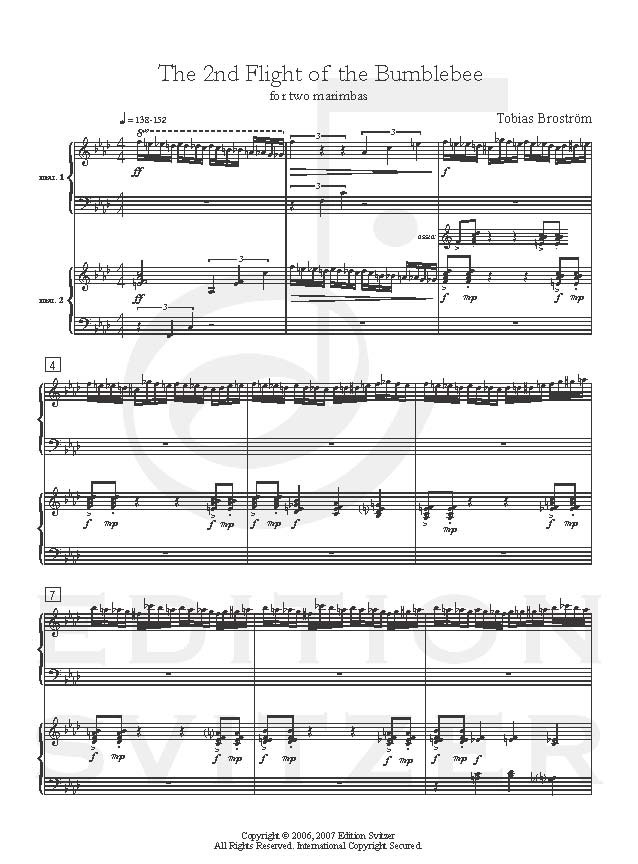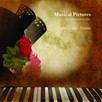
The 2nd flight of the bumblebee
Composer: Tobias Broström
Instrument: Marimba Duo
Level: unknown
Published: 2007
Price: €27.00
Item details
-
Description +
-
Duration: 3 min.
The flight of the 2nd Bumblebee was written during several months' work on two larger orchestral pieces - a peripheral project that lent variation to my other writing. The piece was originally written for two pianos and takes its inspiration from Witold Lutosławski’s Paganini Variations, a highly original transformation of the 24th Caprice for solo violin by Niccolò Paganini. Nikolai Rimsky-Korsakov wrote the well-known Flight of the Bumblebee as part of his opera The Tale of Tsar Saltan, and I have taken the liberty to borrow the main theme from it - my sincere thanks and apologies to Rimsky-Korsakov! Following the presentation of the original and second themes, the development section witnesses the two engaging in intense battle! The piece is three minutes of busy, buzzing music, with the chromatic fragment of the original theme a constant presence.
I hope you enjoy playing it!
-
-
Instrumentation +
-
Two Marimbas (5-octave)
-
-
Watch+
-
About the composer +
-
Tobias Broström was born in 1978 in Helsingborg, Sweden. Following four years of percussion studies at the Malmö Academy of Music, he embarked on the pursuit of a Master’s degree in composition, studying with the Swedish composer Rolf Martinsson and the Italian composer Luca Francesconi.
Broström has composed chamber opera and various chamber music, but during the last years he has mainly focused on orchestral writing in works such as La Danse, Transit Underground, Crimson Skies, Crimson Seas, Kaléidoscope, Violin Concerto, Arena – Percussion Concerto No. 1, Piano Concerto – Belle Epoque, Samsara, Cello Concerto and Lucernaris – Concerto for Trumpet, Live Electronics & Orchestra, which was composed for Håkan Hardenberger. Numerous soloists, conductors, ensembles and orchestras, including, Robin Ticciati, Michael Sanderling, John Storgårds, Anna Larsson, Karen Gomyo, Thomas Søndergård, Andrew Manze, Dima Slobodeniouk, Johannes Gustavsson, Per Tengstrand, Colin Currie, Mats Rondin, Tõnu Kaljuste, Simon Preston, Johan Bridger, Hugo Ticciati, Jaime Martín, BBC Symphony, Detroit Symphony, Dresdner Philharmonie, BBC Philharmonic, Komische Oper Berlin, Symphonieorchester des Bayerischen Rundfunks, Estonian National Orchestra, BBC Scottish Symphony Orchestra, BBC Wales, Gävle SO, Helsingborg SO, Trondheim SO, Malmö SO, Sinfonieorchester St. Gallen, Vogtland Philharmonie, Oviedo SO, NorrlandsOperans SO, Aurora Chamber Orchestra, Brooklyn Rider, Musica Vitae, Third Coast Percussion Quartet, Malleus Incus, Essens:1 and Gageego have performed his works. Tobias’ music have been performed throughout Europe, the USA and Asia.
Between 2006 – 2009 Tobias was Composer-in-Residence with the Gävle Symphony Orchestra under principal conductor Robin Ticciati, resulting in two new orchestral works each year. Two of these, Crimson Seas & Lucernaris were selected by Swedish Radio to represent Sweden in the European Broadcasting Union’s International Rostrum of Composers in 2007 & 2009. In autumn 2008 his Arena – Solo Version was picked out to be performed at the 52nd International Festival of Contemporary Music at the Venice Biennale and his orchestral piece Transit Underground was nominated for best orchestral piece of the year by Swedish Music Publishers’ Association. In 2010 Lucernaris was nominated for best orchestral piece and in 2012 La Danse was nominated.
-
-
Reviews +
-
Review (Percussive Notes, March (58) 2012)
Originally conceived for two pianos, Tobias Broström later adapted this work for marimba duet. Requiring four-mallet technique throughout, one 5.0-octave and one 4.6-octave (low-E) marimba are needed for performance.
After presenting the recognizable theme from Rimsky-Korsakov’s “Flight of the Bumblebee” in homophonic texture, the development section really stirs up the hive. In what the composer calls an “intense battle,” melodic ideas are passed between players at a rapid rate, overlapped, and imitated. Maintaining a connection to the original composition, chromatic fragments of the melody are consistently present.
A suitable and challenging work for a senior or graduate recital, this would also serve as an exciting encore for a professional percussion duo. The energetic sixteenth notes of the melody are used almost exclusively during this three-minute piece. Each marimbist has an equal opportunity to contribute melodic and accompaniment roles. With a familiar theme, this work is sure to leave a “buzzing” impression on any audience.—Darin Olson
Patrick Raab, percussionist at the Royal Danish Orchestra
The second flight of the bumblebee is first of all a very funny to piece to perform. The mix of the original melody from Nikolaj Rimskij-Korsakov and the new theme composed by Broström, complement each other very well and the result speaks for it self.
-
-
Credits +
-
Credits
Front cover graphics and layout: Ronni Kot Wenzell
Copyright © Edition Svitzer
Printed in Copenhagen, Denmark
-


